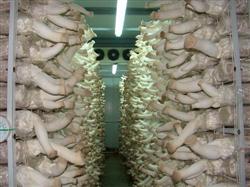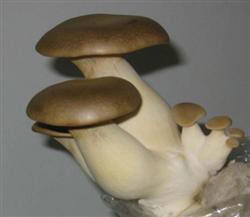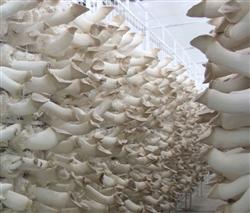How to cultivate Pleurotus eryngii in cold room

How to cultivate Pleurotus eryngii in cold room? Please introduce the cold room cultivation of out-of-season Pleurotus eryngii can refer to the following methods: 1, cold room construction of cold room should choose the sunny flat ground with higher topography, close to the water source and good drainage. Generally, each cold room is 10 m long, 6 m wide and 4 m high, the cold room should not be too large, otherwise it is difficult to control the temperature; around the cold room, the roof adopts color steel plate and foam structure, the bottom of the cold room is covered with foam, then it is poured with cement, the foam thickness is 15 cm, and the joint is fastened with sealing glue. The shelves in the room are made of steel pipes, with 8 beds, each floor of 40 cm, with a work path in the middle, 0.8m wide. Each cold room has one door, which is left on the side, and the multi-span cold room has 2-3 ventilation windows of 0.4 m × 0.6 m each in the middle and upper part of the side. Exhaust fans are installed and closed with fine screen to prevent pests such as mushroom mosquitoes and mushroom flies from flying in. Doors and windows should also be inlaid with foam board and tightly sealed. The refrigeration compressor is located in the middle and lower part, and one compressor is installed in each cold room to control the temperature in the cold room in a suitable range to meet the temperature requirements of Pleurotus eryngii. Adjust the light with movable doors, windows and fluorescent lamps. Spray humidification is realized by a water pipe sprinkler installed in the middle of the mushroom rack. About 10,000 bags can be cultivated in each cold room. 2. Excellent strains are selected. at present, there are many strains of Pleurotus eryngii. It is suggested to use the strain selected by Hebei Institute of Microbiology. 3. The cultivation season is generally arranged to make bags from April to May and produce mushrooms from July to October. 4. Bacterial bag production and mushroom production management 4.1 Culture material formula. The commonly used formula in Pleurotus eryngii cultivation is cottonseed hull 78%, wheat bran 18%, corn (2346, 2.00,0.09%) powder 2%, sugar 1%, gypsum 1%, potassium dihydrogen phosphate 0.3%. 4.2 manufacture of bacterial bags. After the raw material is added according to the formula, the material is mixed with water, and the ratio of material to water is 1 ∶ 1.2-1.3, so that the water content of the material can reach 60-65%. Raw materials should be fresh, mildew-free and pest-free. The mixture should be uniform, especially the cottonseed shell can not have dry grains, otherwise the sterilization will not be complete. After 6 hours of heap stew, 17 cm × 33 cm polyethylene plastic (11280,-35.00,-0.31%) bags were selected and loaded with moderate tightness, and then sterilized under atmospheric pressure after fastening. The temperature was increased to 100 ℃, kept for 16 h, and then stewed for 12 h after the material temperature dropped to 60 ℃. The production process should strictly prevent bacterial bag puncture, grinding and perforation to prevent miscellaneous bacteria pollution. 4.3 bacterial bag inoculation. After sterilization, the bag material was inoculated when the temperature of the bag material dropped below 30 ℃. The inoculation room should be sterilized completely and thoroughly, and the inoculation amount should be 25-30 bags per bag of bacteria, and should be cultured away from light after inoculation. After inoculation, attention should be paid to the cleanliness, dryness and ventilation of the culture room to prevent the influence of high and low temperature and promote the uniform growth of mycelium. And often check, if found that there are miscellaneous bacteria contaminated bags, should be removed in time to deal with, to prevent spread. Generally, the hyphae can be filled with bacteria bags 40-50 days after inoculation. 4.4 Management of mushroom production. After the mycelium grows in the bag, move it into the mushroom shed and open the bag to produce mushroom after budding. 4.4.1 Bud induction. During the mushroom production period, the temperature of the mushroom room should be controlled at 10 ℃-20 ℃, the temperature difference between day and night should be 10 ℃, and the humidity should be 90%-95%. The mushroom buds should be ventilated and given scattered light every day for 10-15 days. 4.4.2 mushroom breeding period. During the fruiting body growth period, the temperature of the mushroom room is controlled at 13 ℃-16 ℃, the humidity is 85%-90%, and the air is ventilated in time to keep the air fresh in the shed and give weak scattered light. (5) Pleurotus eryngii is often polluted by miscellaneous bacteria and invaded by diseases and insect pests in the process of bag making, cultivation and management. The common diseases are green mold, Alternaria rubra, Rhizopus and so on. The main control measures are to strengthen ventilation and avoid excessive humidity. If diseased mushrooms are found, they should be removed in time. The main common pests are mushroom mosquitoes, mushroom flies and so on. The damaged cultivation material turns dark brown, the mushroom buds cannot be formed, and the formed mushroom buds and young buds will shrink and rot. Prevention-oriented and comprehensive prevention and control measures should be taken: first, isolation and protection, installing 60-80 mesh window screens on the doors and windows of cold rooms to prevent adults from flying in, spawning and breeding; second, light trapping. Adults have phototaxis and can be trapped and killed by black light. Third, chemical control. After the opening of the bacterial bag and after mushroom picking, the material surface can be sprayed with 3000 times of 5% Regent EC or 25% Aktai 3000-4000 times. Click to get more cultivation techniques of Pleurotus eryngii
- Prev

How to cultivate Pleurotus eryngii twice a year
How to cultivate Pleurotus eryngii twice a year? Please guide Pleurotus eryngii, mainly edible mushroom stalk, which is favored by the market because of its fresh and tender taste and pleasant aroma of almonds. It is understood that in recent years, the market has been in short supply, and the seasonal sales price is very high. Production and management benefits are considerable.
- Next

How to cultivate Pleurotus eryngii to achieve high yield
How can Pleurotus eryngii be cultivated with high yield? Please advise Pleurotus eryngii cultivation to have high yield can refer to the following methods: first, the selection and proportion of raw materials Pleurotus eryngii is a kind of fungus with strong ability to decompose cellulose and lignin. Its main cultivation raw materials are sawdust, cottonseed hull, corncob and so on, and the auxiliary materials are wheat bran, rice bran and corn.
Related
- Fuxing push coffee new agricultural production and marketing class: lack of small-scale processing plants
- Jujube rice field leisure farm deep ploughing Yilan for five years to create a space for organic food and play
- Nongyu Farm-A trial of organic papaya for brave women with advanced technology
- Four points for attention in the prevention and control of diseases and insect pests of edible fungi
- How to add nutrient solution to Edible Fungi
- Is there any good way to control edible fungus mites?
- Open Inoculation Technology of Edible Fungi
- Is there any clever way to use fertilizer for edible fungus in winter?
- What agents are used to kill the pathogens of edible fungi in the mushroom shed?
- Rapid drying of Edible Fungi

